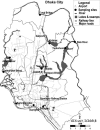Self-limiting nature of seasonal cholera epidemics: Role of host-mediated amplification of phage
- PMID: 15829587
- PMCID: PMC1087956
- DOI: 10.1073/pnas.0502069102
Self-limiting nature of seasonal cholera epidemics: Role of host-mediated amplification of phage
Abstract
Phage predation of Vibrio cholerae has recently been reported to be a factor that influences seasonal epidemics of cholera in Bangladesh. To understand more about this phenomenon, we studied the dynamics of the V. cholerae-phage interaction during a recent epidemic in Dhaka. Because the outbreak strain causing this epidemic was resistant to multiple antibiotics, including streptomycin, we used a selective medium containing streptomycin to monitor accurately the abundance of this strain in the environment. The changing prevalence in the environment of the epidemic V. cholerae O1 strain and a particular lytic cholera phage (JSF4) to which it was sensitive was measured every 48-72 h for 17 weeks. We also monitored the incidence of phage excretion in stools of 387 cholera patients during the epidemic. The peak of the epidemic was preceded by high V. cholerae prevalence in the environment and was followed by high JSF4 phage levels as the epidemic ended. The buildup to the phage peak in the environment coincided with increasing excretion of the same phage in the stools of cholera patients. These results suggest that patients toward the end of the epidemic ingested both JSF4 phage and the outbreak V. cholerae strain. Host-mediated phage amplification during the cholera epidemic likely contributed to increased environmental phage abundance, decreased load of environmental V. cholerae and, hence, the collapse of the epidemic. Thus, in vivo phage amplification in patients and subsequent phage predation in the environment may explain the self-limiting nature of seasonal cholera epidemics in Bangladesh.
Figures




Similar articles
-
Effect of phage on the infectivity of Vibrio cholerae and emergence of genetic variants.Infect Immun. 2008 Nov;76(11):5266-73. doi: 10.1128/IAI.00578-08. Epub 2008 Sep 15. Infect Immun. 2008. PMID: 18794293 Free PMC article.
-
Seasonal epidemics of cholera inversely correlate with the prevalence of environmental cholera phages.Proc Natl Acad Sci U S A. 2005 Feb 1;102(5):1702-7. doi: 10.1073/pnas.0408992102. Epub 2005 Jan 14. Proc Natl Acad Sci U S A. 2005. PMID: 15653771 Free PMC article.
-
An improved technique for isolation of environmental Vibrio cholerae with epidemic potential: monitoring the emergence of a multiple-antibiotic-resistant epidemic strain in Bangladesh.J Infect Dis. 2006 Apr 1;193(7):1029-36. doi: 10.1086/500953. Epub 2006 Feb 21. J Infect Dis. 2006. PMID: 16518766
-
Environmental reservoirs of Vibrio cholerae.Vaccine. 2020 Feb 29;38 Suppl 1:A52-A62. doi: 10.1016/j.vaccine.2019.06.033. Epub 2019 Jul 5. Vaccine. 2020. PMID: 31285087 Review.
-
Role of phages in the epidemiology of cholera.Curr Top Microbiol Immunol. 2014;379:165-80. doi: 10.1007/82_2013_358. Curr Top Microbiol Immunol. 2014. PMID: 24213557 Review.
Cited by
-
Bacteriophage-Host Interactions and Coevolution.Methods Mol Biol. 2024;2738:231-243. doi: 10.1007/978-1-0716-3549-0_15. Methods Mol Biol. 2024. PMID: 37966603
-
An experimental study of the population and evolutionary dynamics of Vibrio cholerae O1 and the bacteriophage JSF4.Proc Biol Sci. 2010 Nov 7;277(1698):3247-54. doi: 10.1098/rspb.2010.0651. Epub 2010 Jun 10. Proc Biol Sci. 2010. PMID: 20538647 Free PMC article.
-
Screening of Potential Vibrio cholerae Bacteriophages for Cholera Therapy: A Comparative Genomic Approach.Front Microbiol. 2022 Mar 29;13:803933. doi: 10.3389/fmicb.2022.803933. eCollection 2022. Front Microbiol. 2022. PMID: 35422793 Free PMC article.
-
Environmental reservoirs and mechanisms of persistence of Vibrio cholerae.Front Microbiol. 2013 Dec 16;4:375. doi: 10.3389/fmicb.2013.00375. Front Microbiol. 2013. PMID: 24379807 Free PMC article. Review.
-
Evolutionary consequences of intra-patient phage predation on microbial populations.Elife. 2014 Aug 26;3:e03497. doi: 10.7554/eLife.03497. Elife. 2014. PMID: 25161196 Free PMC article.
References
-
- Khan, M. U., Shahidullah, M., Haque, M. S. & Ahmed, W. U. (1984) Trop. Geogr. Med. 36, 335-340. - PubMed
-
- Jouravleva, E. A., McDonald, G. A., Gaon, C. F., Boesman-Finkelstein, M. & Finkelstein, R. A. (1998) Microbiology 144, 315-324. - PubMed
-
- Faruque, S. M. & Mekalanos, J. J. (2003) Trends Microbiol. 11, 505-510. - PubMed
Publication types
MeSH terms
Grants and funding
LinkOut - more resources
Full Text Sources
Other Literature Sources
Medical

